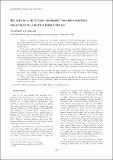Files in this item
Big bees do a better job : intraspecific size variation influences pollination effectiveness
Item metadata
| dc.contributor.author | Willmer, Patricia Gillian | |
| dc.contributor.author | Finlayson, Kathryn | |
| dc.date.accessioned | 2015-09-24T14:10:02Z | |
| dc.date.available | 2015-09-24T14:10:02Z | |
| dc.date.issued | 2014-09 | |
| dc.identifier | 162433236 | |
| dc.identifier | 7d0df95d-9c84-4456-8679-ab0c67f0ddbc | |
| dc.identifier.citation | Willmer , P G & Finlayson , K 2014 , ' Big bees do a better job : intraspecific size variation influences pollination effectiveness ' , Journal of Pollination Ecology , vol. 14 , no. 23 , pp. 244-254 . | en |
| dc.identifier.issn | 1920-7603 | |
| dc.identifier.uri | https://hdl.handle.net/10023/7535 | |
| dc.description | Funding: School of Biology, University of St Andrews | en |
| dc.description.abstract | Bumblebees (Bombus spp.) are efficient pollinators of many flowering plants, yet the pollen deposition performance of individual bees has not been investigated. Worker bumblebees exhibit large intraspecific and intra-nest size variation, in contrast with other eusocial bees; and their size influences collection and deposition of pollen grains. Laboratory studies with B. terrestris workers and Vinca minor flowers showed that pollen grains deposited on stigmas in single visits (SVD) were significantly positively related to bee size; larger bees deposited more grains, while the smallest individuals, with proportionally shorter tongues, were unable to collect or deposit pollen in these flowers. Individuals did not increase their pollen deposition over time, so handling experience does not influence SVD in Vinca minor. Field studies using Geranium sanguineum and Echium vulgare, and multiple visiting species, confirmed that individual size affects SVD. All bumblebee species showed size effects, though even the smallest individuals did deposit pollen, whereas there was no detectable effect with Apis with its limited size variation. Two abundant hoverfly species also showed size effects, particularly when feeding for nectar. Mean size of foragers also varied diurnally, with larger individuals active earlier and later, so that pollination effectiveness varies through a day; flowers routinely pollinated by bees may best be served by early morning dehiscence and visits from larger individuals. Thus, while there are well-documented species-level variations in pollination effectiveness, the fine-scale individual differences between foragers should also be taken into account when assessing the reproductive outputs of biotically-pollinated plants. | |
| dc.format.extent | 11 | |
| dc.format.extent | 615315 | |
| dc.language.iso | eng | |
| dc.relation.ispartof | Journal of Pollination Ecology | en |
| dc.subject | Pollinator | en |
| dc.subject | Pollen deposition | en |
| dc.subject | Bumblebee | en |
| dc.subject | Body size | en |
| dc.subject | Intraspecific variation | en |
| dc.subject | QH301 Biology | en |
| dc.subject.lcc | QH301 | en |
| dc.title | Big bees do a better job : intraspecific size variation influences pollination effectiveness | en |
| dc.type | Journal article | en |
| dc.contributor.institution | University of St Andrews. School of Biology | en |
| dc.contributor.institution | University of St Andrews. Scottish Oceans Institute | en |
| dc.contributor.institution | University of St Andrews. Institute of Behavioural and Neural Sciences | en |
| dc.contributor.institution | University of St Andrews. St Andrews Sustainability Institute | en |
| dc.description.status | Peer reviewed | en |
| dc.identifier.url | http://www.pollinationecology.org/index.php?journal=jpe&page=article&op=view&path%5B%5D=301 | en |
This item appears in the following Collection(s)
Items in the St Andrews Research Repository are protected by copyright, with all rights reserved, unless otherwise indicated.

